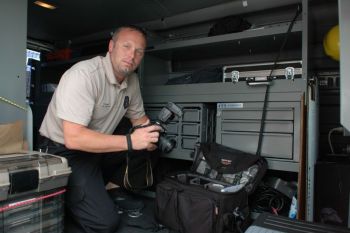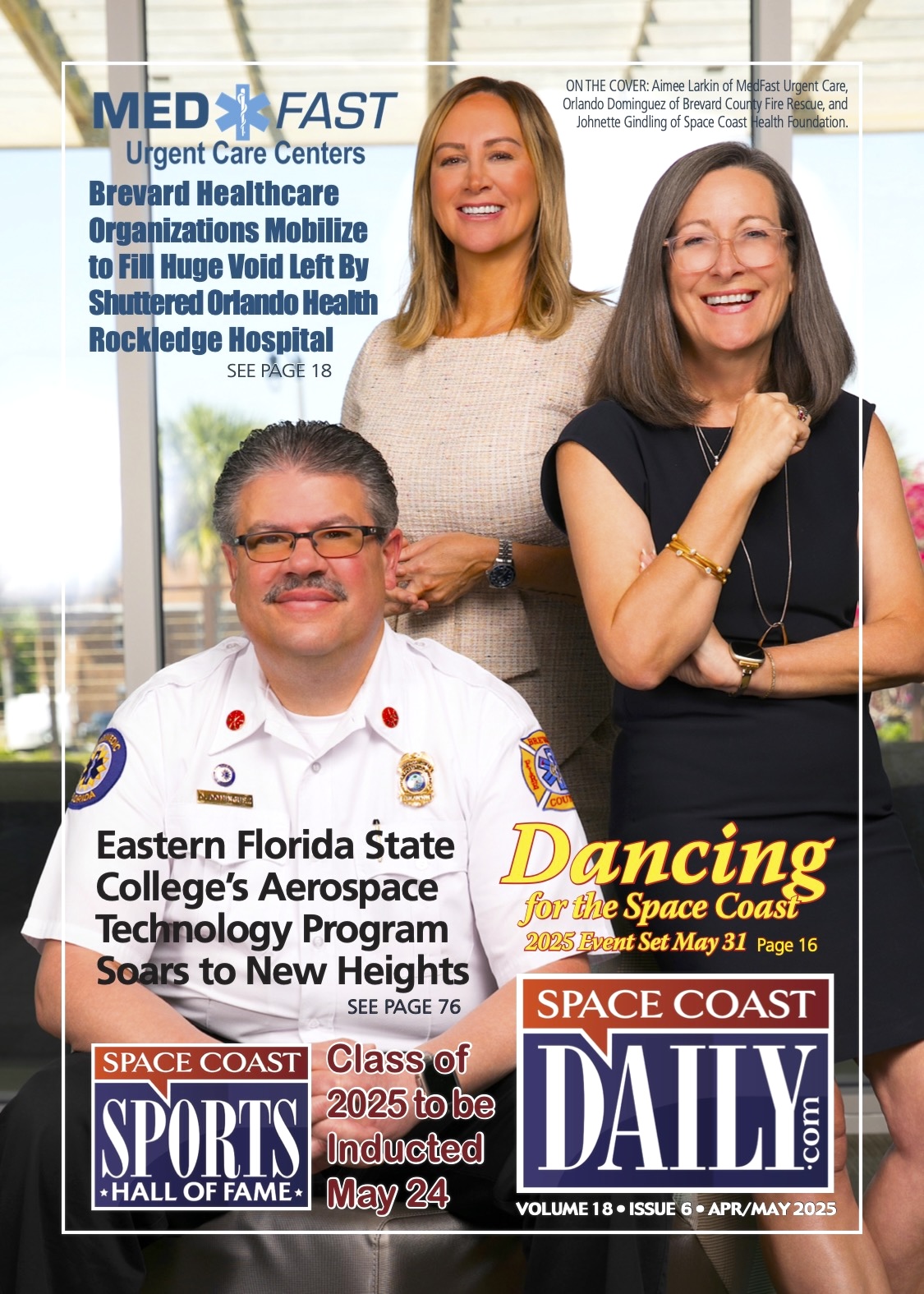Palm Bay CSI Unit Embraces Fine Art Of Forensics
By John M. Egan // April 25, 2013
High-Tech Investigations
[dopwgg id=”74″]
BREVARD COUNTY • PALM BAY, FLORIDA – Many of us can recall the infamous O.J. Simpson case of 1994, when the prosecution introduced a new form of forensic evidence.

DNA, or Deoxyribonucleic acid, is a nucleic acid whose characteristics are exclusive to every individual.
The Technical Services Unit of the Palm Bay Police Department consists of a highly trained team of civilian and law enforcement forensic professionals that is skilled in the field of DNA, latent fingerprint examination, various evidence-gathering techniques through chemical processes, photography, computers, cellular phones, text messaging, video surveillance and numerous other investigative methods.
While DNA analysis was in its infancy and seeking recognition as indisputable and admissible evidence in the Simpson case, it is no longer as confusing as it was at that time.
Palm Bay’s elite team of forensics experts is ready at a moment’s notice to collect vital evidence crucial to solving cases and earning convictions.
When summoned to a crime scene by an assigned detective, the Technical Services’ Crime Scene Unit responds to the scene and sets out to make forensic sense out of crimes through the process of meticulous evidence gathering and precise documentation.

Behind the scenes
“I enjoy the science side of law enforcement,” said Crime Scene Technician Alicia Miller of Palm Bay. “You are behind the scenes, but you get knee-deep in the investigation. You analyze latent fingerprints and blood for DNA, their spatter patterns by measuring their distance from a floor or table to a wall, an appliance, curtains, window, or the victim. We reconstruct shooting scenes through a laser, transparent tubes and wood rods which when all assembled, define a projectile trajectory. All our findings are documented with the use of some special cameras and lenses designed for various distances and lighting conditions.”
Back in 1986, Dr. Alec J. Jeffreys of the University of England coined the term DNA fingerprints. The process was first introduced as forensic evidence in a criminal trial there when local police asked him to prove if their suspect was responsible for two rape-related murders in a rural community. Tests proved their suspect had not committed the crime.
Subsequently police obtained blood samples from over several thousand male inhabitants of the area and in 1987, blood evidence from that crime scene and a blood sample provided by one of those several thousand local residents discovered a match in a match named Robert Melias. He became the first person in England convicted of a crime based upon DNA evidence.

First Use in America
One of the first uses of DNA evidence in the United States occurred in 1987. The Circuit Court of Orange County here in Florida convicted Tommy Lee Andrews of a rape after a DNA test of his blood matched the DNA of seminal fluid found in the victim.
Some 25 years later, DNA evidence collection is routine and most police departments and prosecutors use it to solve crimes.
And Palm Bay’s Technical Services Unit is one of the best at doing that.
“Our training consists of processing a crime scene through the gathering and documentation of material and biological evidence,” Miller said. “Biological evidence is described as blood, tissue, body fluids and saliva. We also train about how to obtain latent fingerprints from broken glass, weapons, fuel containers, tools, pill bottles and drug paraphernalia all through a special chemical process with the use of super glue.”
She described the process.

Methods
“A drop or two of the super glue, along with the piece of evidence is placed in a chemical fume hood chamber.” Miller said. “When the glue is heated, it creates fumes. It is those fumes that adhere to the oils in the prints and they become visible. We’re also trained in safety procedures at a crime scene and use forensic photography and alternate light sources through high intensity bulbs, ultraviolet light, lasers and filters. We are trained in the proper decorum when testifying in court, securing and documenting of evidence and maintaining their chain of custody for presentation in court.”
In May, Miller testified in court involving evidence in the major Palm Bay case of Fredrick Rogers.
He was accused by Palm Bay police and then subsequently convicted of aggravated assault of assaulting his girlfriend and her 14-year son by tossing liquid drain cleaner (sulfuric acid ) on them as them as they sat in a car.
“I processed that crime scene,” said Miller. “I collected samples of the acid from the car and photographed the car and its interior. The following day I went to the hospital where the victims were admitted and photographed each victim’s injury and their respective clothing worn at the time of the crime.”
Among many of her duties, Miller maintains the department’s DNA data base which is integrated with those of other police departments.
“We collect reference samples from individuals taken into custody,” said Miller. “This information is submitted to our data base and compared to our evidence samples which are collected at burglaries, shootings, robberies and property crimes such as shoplifting, auto theft and larceny. Through this data base we have experienced an increased closure rate of our property crimes.”

Meaningful work
Crime Scene Technician Phil Clendenin of West Melbourne has been with the Palm Bay CSI unit for more than six years.
“After I received my degree in crime scene technology from Brevard Community College, I applied for the position with the Palm Bay Police Department,” Clendenin said. “Shortly after I applied, there was an opening and I was hired.”
He said he finds the work meaningful and rewarding in helping to solve crimes.
“Every day is different, every scene is different and there is always something constantly changing in the world of crime scene investigation, you just don’t know what the day or evening or morning will bring.” Palm Bay crime scene technician Phil Clendenin
“Every day is different,” Clendenin said. “You come to work each day and don’t know what you will have from day to day. Every day is different, every scene is different and there is always something constantly changing in the world of crime scene investigation, you just don’t know what the day or evening or morning will bring. When I come upon a challenging crime scene, I go into that scene and think like that criminal. At a burglary, I look at areas he or she may have touched, or an item they may have been left at the scene — a cigarette, or a soda can from the refrigerator that perpetrator may have drunk from before leaving. These are just some of the many things you have to look for when you arrive on the scene.”
The technical aspect of the investigation aspect of crime scene investigation in Palm Bay is the domain of Detective Greg Guillette of Palm Bay,
Prior to his appointment with the Palm Bay Police Department in 2006, Guillette served more than six years with the Coventry (R.I) Police Department as a patrol officer.
After serving a year of patrol duty for the Palm Bay Police Department, Guillette was promoted to detective and assigned to the department’s Special Victims Unit. While there, he was afforded the opportunity to become an investigator specializing in digital forensics.

Master Sleuth
Through a partnership with the Palm Bay Police Department and the U.S. Secret Service in Orlando, Detective Guillette was trained at the National Computer Forensics Institute and provided with the equipment necessary to conduct digital forensic investigations.
“My job is to try and solve crimes through the use of technology,” Guillette said. “For the most part, I try to locate the digital evidence through the use of advance computer techniques and the use of advanced surveillance technologies. My duties include performing digital forensic examinations on computers and cell phones.
“Digital forensics is a branch of forensic science encompassing the recovery and investigation of material found on digital devices,” he said. “I have worked a wide range of major cases from sexual battery to embezzlement and gambling-related offenses.”
Guillette praised the support his unit is given from the Palm Bay Police Department leadership.
“Extensive training is required and it’s a considerable expense to equip a digital forensic lab,” he said. “But without the support of former Chief Bill Berger and Chief Doug Muldoon and Deputy Chief John Blackledge and our partnership with the U.S. Secret Service Task Force, we would not be where we are today.”
He said advances in technology are significant for investigators.
“There is just so much evidence on these devices, and any departments that fail to examine them, in my opinion, are missing a source of considerable evidence,” Guillette said. ”It is as important as gathering DNA and fingerprints. That cell phone or computer can tell me more about you than your best friend.”













Wonderful story John, very informative and interesting.
This was an informative and interesting article. I don’t think the average person realizes how much technical expertise and science are involved in investigations. I enjoyed reading about these diverse methods and am happy to know that we have such well trained professionals working here in Brevard County.
What a great article!!! Keep them coming, love reading the CSI.
John,great story love csi very proud of you,love you sister jean
Great story John! The article was very interesting. Keep up the good work.
Hey John, looks like your well. Your old neighbor from penn manor apt. # 49. Marty smith
Interesting article describing the role of crime labs.
From the article:
“He was accused by Palm Bay police and then subsequently convicted of aggravated assault of assaulting his girlfriend and her 14-year son by tossing liquid drain cleaner (sulfuric acid ) on them as them as they sat in a car.”
Sulfuric acid is never used as a drain cleaner…it would destroy most plumbing. If you look at drain cleaners, they are usually Sodium Hydroxide – a powerful base, not acid.
Positve team member, wish you guys the best in fighting crime.